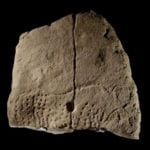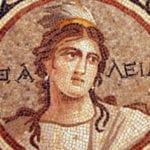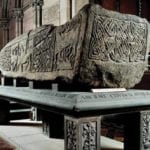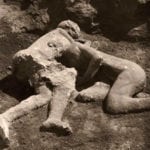 Weird Stuff
Weird Stuff  Weird Stuff
Weird Stuff  Our World
Our World 10 Ways Your Christmas Tree Is More Lit Than You Think
 Movies and TV
Movies and TV The 10 Coolest Stars to Set Sail on The Love Boat
 History
History 10 Things You Didn’t Know About the American National Anthem
 Technology
Technology Top 10 Everyday Tech Buzzwords That Hide a Darker Past
 Humans
Humans 10 Everyday Human Behaviors That Are Actually Survival Instincts
 Animals
Animals 10 Animals That Humiliated and Harmed Historical Leaders
 History
History 10 Most Influential Protests in Modern History
 Creepy
Creepy 10 More Representations of Death from Myth, Legend, and Folktale
 Technology
Technology 10 Scientific Breakthroughs of 2025 That’ll Change Everything
 Weird Stuff
Weird Stuff Ten Bizarre Facts About The Doge Meme
 Our World
Our World 10 Ways Your Christmas Tree Is More Lit Than You Think
 Movies and TV
Movies and TV The 10 Coolest Stars to Set Sail on The Love Boat
Who's Behind Listverse?

Jamie Frater
Head Editor
Jamie founded Listverse due to an insatiable desire to share fascinating, obscure, and bizarre facts. He has been a guest speaker on numerous national radio and television stations and is a five time published author.
More About Us History
History 10 Things You Didn’t Know About the American National Anthem
 Technology
Technology Top 10 Everyday Tech Buzzwords That Hide a Darker Past
 Humans
Humans 10 Everyday Human Behaviors That Are Actually Survival Instincts
 Animals
Animals 10 Animals That Humiliated and Harmed Historical Leaders
 History
History 10 Most Influential Protests in Modern History
 Creepy
Creepy 10 More Representations of Death from Myth, Legend, and Folktale
 Technology
Technology 10 Scientific Breakthroughs of 2025 That’ll Change Everything
10 Amazing Archaeological Finds Discovered In Pompeii
When Pompeii was first discovered, wealthy young gentlemen were expected to embark on Europe-wide tours to learn the continent’s history. A visit to Pompeii quickly became a key part of this rite of passage. These gentlemen took their experiences home, where they used their wealth and influence to patronize the Neoclassical movement.
Since it was first excavated in the 1700s, Pompeii has given us thousands of finds, some of which changed our understanding of ancient Roman culture. While this helped us understand the Romans like never before, the discovery of shockingly explicit frescoes and statues offended the sensibilities of the people of the Enlightenment.
They hid many of them away in private collections. These more controversial facets of Pompeii (and Roman culture in general) are still glossed over in classrooms today, but their archaeological importance cannot be denied.
Pompeii has consistently been a source of finds that fundamentally shape our understanding of the Roman world. In 2018 alone, two new discoveries helped to shed light on the daily lives of the Pompeiians. In this list, we’re investigating 10 of the most amazing archaeological discoveries found in Pompeii.
10 Ancient Graffiti
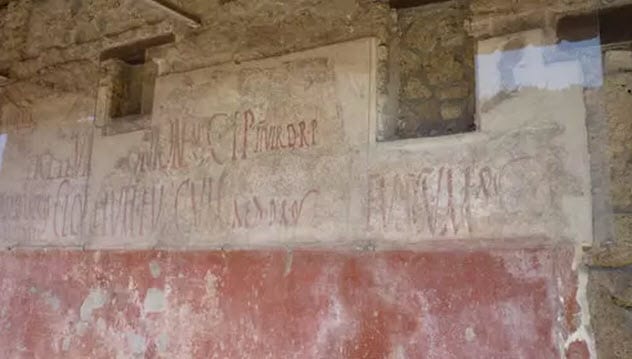
We forget that the Romans produced a lot of writing, especially in comparison to other societies. Most of these texts have sadly been lost now.
But at the time, most public figures would have produced some writing which they hoped would boost their political standing back home. It was this that inspired Julius Caesar to produce a multivolume account of his Conquest of Gaul, which featured many embellishments to make him more appealing as a political leader.
Even among the uneducated classes, politics was a highly emotive issue. Political graffiti was as common as any other type of graffiti on the walls of Roman towns.
In perfectly preserved Pompeii, however, we get to see a much rarer form of Roman street art: the kind that was painted onto walls instead of scratched in with a rock or knife. This kind of graffiti is much more perishable but has survived in Pompeii under meters of ash.
Some political graffiti may have been paid for by the candidates themselves as some of them are very simple: “I ask that you elect [name] as [position]” was a common form of graffiti in Pompeii. Others, though, were more advanced, and one appears to be an attack ad: “All the deadbeats and Macerius ask for Vatia as aedile.”[1]
Of course, the Romans were more sexually open than many other people in history and their graffiti could be extremely graphic. “I don’t care about your pregnancy, Salvilla; I despise it” and “Romula sucks her man here and everywhere” are two of the less explicit examples of lewd graffiti discovered at Pompeii.
9 The Villa Of The Mysteries
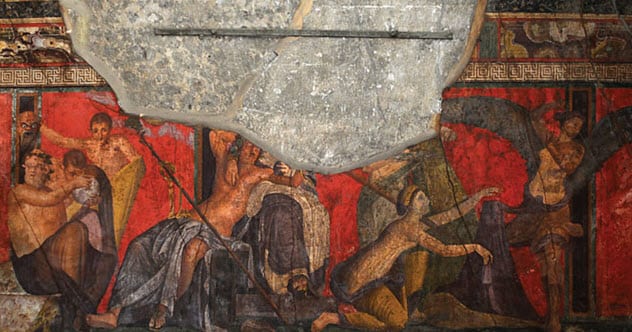
The Villa of the Mysteries (Villa dei Misteri) is a well-preserved old Roman villa that was likely the home of a powerful family. Like most expensive homes of the time, the villa is not located within Pompeii but lies on the road just outside it.
Despite being covered with ash during the Vesuvius eruption, it remains remarkably intact. The majority of its walls and ceilings survived with only minor damage. Most importantly, though, its stunning frescoes are still almost whole, making them some of the best-known examples of Roman painting we have today.
Experts disagree over what the frescoes actually depict. But the most common assumption is that they show a young woman going through the rites of induction to a special secret cult of Dionysus, the god of wine.
Incidentally, a Roman wine press was also discovered at the site. This would have made it easy for the family to make its own alcohol. The rest of the house, which was more than 200 years old by the time of the eruption, featured baths, gardens, shrines, and several large kitchens which, along with the farm outside, would have made it largely self-sustaining.[2]
When the site was first uncovered in 1909, it was extraordinarily vulnerable to the elements. Within months, the walls and paintings had sustained water damage and the paint was starting to fade.
Early attempts to use wax to protect the surface gave the frescoes an unwanted glossy appearance and, over time, darkened and yellowed the paint. In 2013, however, an extensive program was started with the ambition of restoring and preserving the site. Study and conservation are much less intrusive than they were in the past, and the site is now in much better shape.
8 A Horse Wearing A Harness
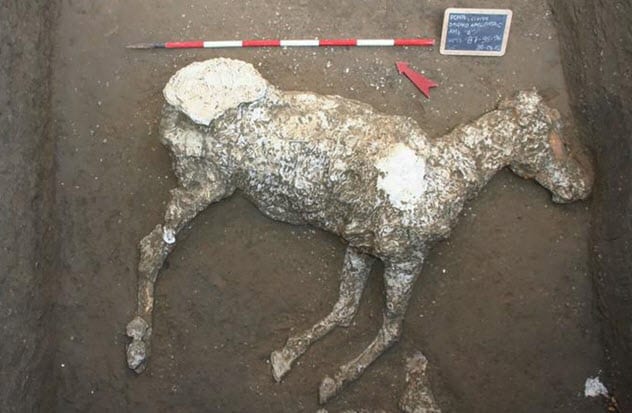
In 2018, excavations taking place in some stables outside the Villa of The Mysteries uncovered at least three horses which had been buried by ash from the eruption. A tragic occurrence, but it was also incredibly useful for historians because two of the horses were wearing harnesses. One also wore a saddle.
They may have been harnessed as part of a failed last-minute attempt to flee the volcanic eruptions. Harnesses from Roman times are incredibly rare finds.
As they are so unusual and evidence is generally lacking, discussions continue over how exactly Romans rode horses in both peace and wartime. While the remains are in poor shape, they may in the future help shed some light on precisely what horse-related equipment was available to the average Roman rider at the time and how it was used.[3]
Interestingly, the horses were discovered as part of a law enforcement investigation led by the Italian police. Operation Artemis was launched in 2014 after thieves stole a Roman fresco. By 2015, the operation had resulted in the arrest of more than 140 suspects across 22 Italian provinces and the recovery of over 2,000 illegally acquired artifacts.
7 Lupanare
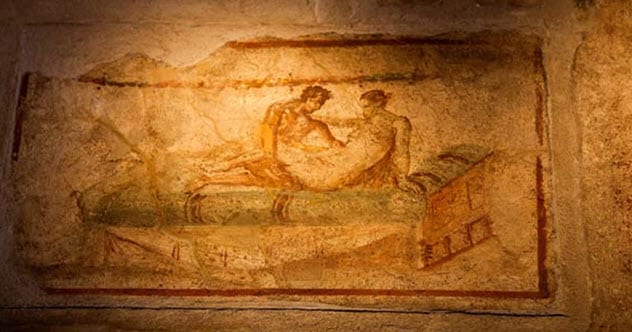
The Romans were much more open about sex than we are today. Phallic symbols frequently appeared in both religious and everyday imagery and could be found everywhere from the walls of temples to the city streets.
Brothels were completely legal in ancient Rome. The use of prostitutes was not criticized if people conducted themselves with self-control and were not seen as being overly desperate or addicted to sex. Perhaps most shockingly to us, though, a particular brothel in Pompeii seems to have used lewd frescoes on its main room as a way of advertising what services were available to visitors.[4]
In much the same way as we can stare at the rotating menu board in McDonald’s as we wait for our order today, those guests who were waiting for a prostitute or a room could view a wide assortment of different sexual services and positions.
The brothel itself, called the Lupanare (“Wolf’s Den”), was a two-story building with 10 rooms and a lavatory which had been built just years before the eruption. It seems to have been the only building in Pompeii that was intended to be a brothel from the start.
In typical Roman fashion, the walls are adorned with over 100 graffiti messages.
6 A Roman Launderette
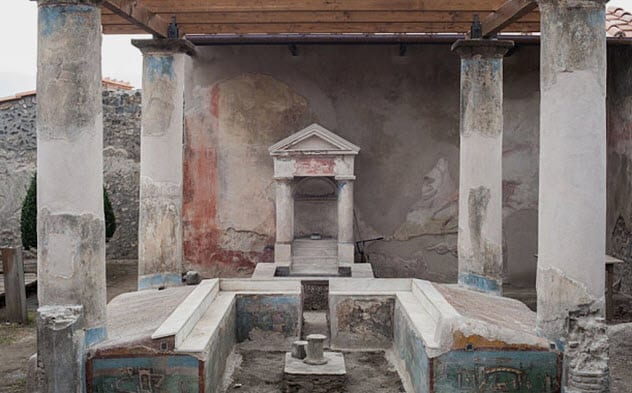
Many of the poorer urban Romans lived in multistory apartment blocks, the likes of which would not look entirely out of place in our cities today. And just like modern people, the Romans needed a place to wash their clothes.
These places of accommodation were often too small to host the full range of equipment needed for washing clothes back then. As a result, many of these urbanites would have taken their clothes to the local launderette instead.
Archaeologists have restored and opened an old Roman building which was the place where your average Roman brought their clothes to be washed and dried back in the day. The facility, which is now open to the public, featured large baths for washing and a press which would have been used for ironing. The building also contained several stone basins which would have been used for dyeing.
The Romans used urine to clean their clothes because it was both readily available and fairly acidic. As such, the launderette would almost certainly have maintained a large supply of urine collected from the city’s various public toilets. Once the clothes had been washed, they were left on the roof to dry, which no doubt would have created a nasty smell.[5]
5 A Perfectly Preserved Shrine
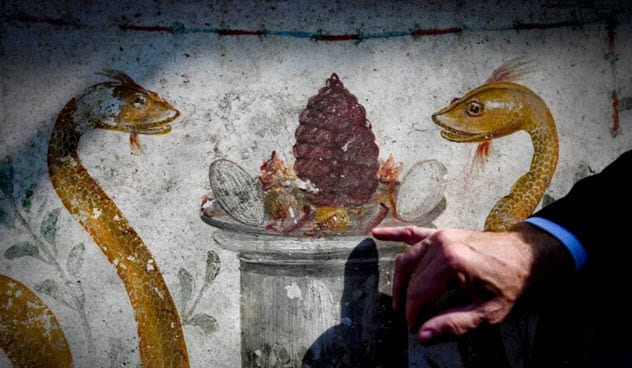
Another 2018 discovery, this perfectly preserved shrine was found in one of the previously unexcavated parts of the city. The ash which buried Pompeii protected it from water, air, and sun erosion, keeping the paintings vibrant and fresh.
It’s likely that most of the frescoes across Pompeii looked like this when the city was rediscovered in the 18th century. But the amateur archaeologists of the 1700s didn’t have the knowledge or the tools to prevent the frescoes from weathering over time.
Now, however, we have a chance to look upon a beautiful fresco in all its original glory. The small room features several different paintings, including a shrine flanked by guardian snakes, a hunting scene on a vivid red background, and a man with a dog’s head who might be a Roman interpretation of the Egyptian god Anubis. Elsewhere, the room also contained a pool, marking the house as one of Pompeii’s more expensive properties.[6]
Perhaps most impressive, though, is the painting of a lifelike peacock which is framed to look as though it’s walking in another part of the shrine’s garden. Since medieval artwork was highly symbolic and rarely resembled the real world, it is often assumed that art as we know it today came about during the Renaissance. Finds like this help to dispel that myth and remind people that the Romans were perfectly capable of producing lifelike art.
4 Varied Food

It is commonly believed that the Roman elite ate a wide range of exotic delicacies while the average man or woman lived on boring bread or grains. Most of us have heard the myth that the “Vomitorium” was a room where the rich Romans would make themselves sick so they could carry on eating.
A wide-ranging survey of 20 shops near one of Pompeii’s gates has revealed a host of new information about the diets of average urban Romans. It seems that wealthier Romans could indeed afford strange, varied foods, the likes of which we would flat out refuse to eat today.
The drain of an eatery contained the remains of imported shellfish, sea urchin, and a giraffe’s bone. The drain also contained traces of spices and other flavorings from places as far away as Indonesia.
However, the study revealed that the diets of everyday Romans could be surprisingly varied, too—at least for those who lived in the city. The average resident of Pompeii lived on a diet somewhat like the Mediterranean diet of today. They consumed mainly lentils, olives, nuts, and fish alongside the occasional portion of salted meat.[7]
3 The Bread Fresco
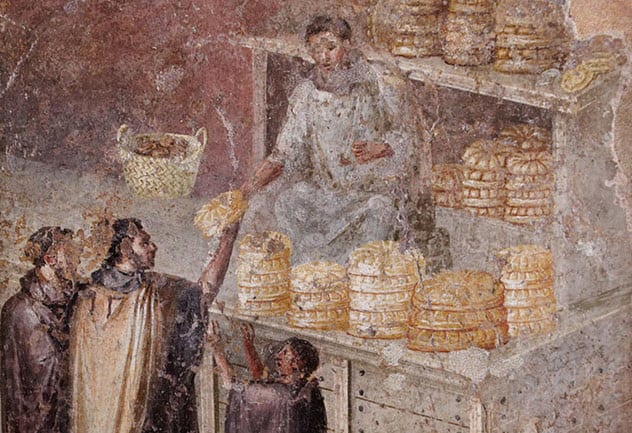
While many of the Pompeiian frescoes depict grand events such as religious festivals or great historic battles, some are concerned with more mundane affairs. One of the greatest “everyday” frescoes is called The Sale Of Bread.
Its name is a misnomer because the fresco actually shows a politician in a toga distributing bread to citizens for free. Many Roman sources tell us that politicians would provide gifts to build political support. But this mostly came in the form of hosting gladiator games, which were often politically funded and free for the average person to enter.[8]
This fresco, though, shows us how political campaigning worked in the Roman world. Much like how politicians will host surgeries and meetings with their constituents today, it was not uncommon for a Roman who aspired to high office to take to the streets with gifts and ideas in an effort to drum up support.
It is also important because it depicts Roman furniture. In the fresco, we can see a wicker basket, a countertop, and some shelves. All these things would never survive into the modern day because they’re made from perishable materials. Such paintings are therefore essential to our understanding of what everyday urban environments looked like for most Romans.
2 The Stabian Baths
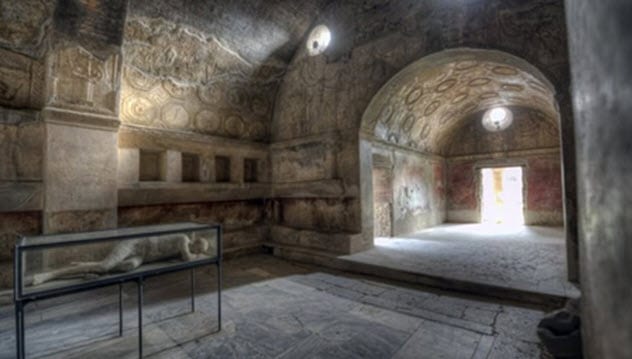
The Stabian baths are the oldest baths in Pompeii and some of the earliest Roman baths still standing. First built in 120 BC, they cover over 900 meters (3,000 ft) of ground and contain two different sections—one for men and one for women.
Each section contained several rooms, including cold, warm, and hot bathing rooms. There was also a courtyard, a gymnasium, and a central pool. A block of lavatories was added much later. The women’s section even contained a room full of bronze baths for individual bathing in case a visitor didn’t want to share someone else’s water.
As some of the oldest baths in the Roman Empire, the Stabian baths had few windows and were more poorly lit than the other bathing facilities in the city. Even so, it seems that the baths were still in use when the eruption occurred. By that time, they would have been almost two centuries old.
They are still standing today and, in some places, even retain their original Roman plaster, decorations, and roof. Visitors can still walk their halls today and see everything from the advanced central heating system to the holes in the plaster where renovations were ongoing when the city was destroyed.[9]
1 The Secret Erotica Museum

Some Roman practices are disturbing to our modern sensibilities and were even more alarming to the Victorian and medieval people who sometimes encountered them. It is rumored that when Count Muzzio Tuttavilla accidentally discovered the ruins of Pompeii in the 1590s, he found sexually explicit frescoes and purposely reburied them, leaving them undiscovered for another century.
Whether or not that is true, shortly after excavation of Pompeii began in earnest in the 1800s, the diggers uncovered frescoes and statues which they believed were indecent, if not outright immoral. Before long, the king of Naples established a secret museum which could only be viewed by men of an upright moral standing.
Many of Pompeii’s more erotic artworks were removed from the site and taken to Naples to be hidden away in this special museum, which quickly became infamous. It was opened for a brief time in the 1860s after Italy was united by Garibaldi and then again in the 1960s.
But it wasn’t permanently opened to the public until 2000. It contains some finds which people would deem questionable even today. These include a whole collection of uncircumcised stone penises and a satyr (half-goat, half-man) mating with a female goat.[10]
For more fascinating facts about Pompeii, check out Top 10 Interesting Things About The People Of Pompeii and 10 Fascinating Facts About The Ancient City Of Pompeii.
